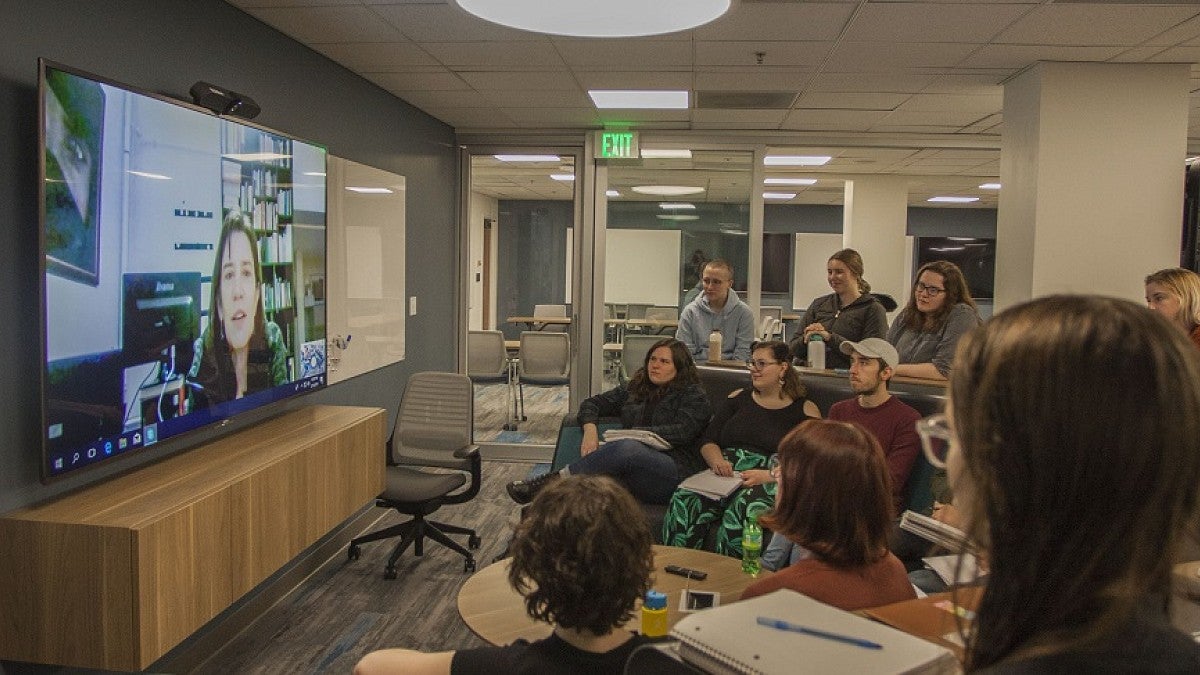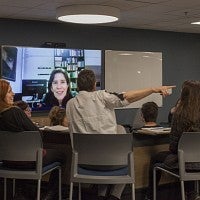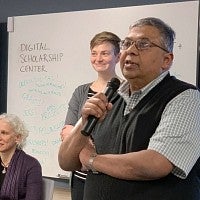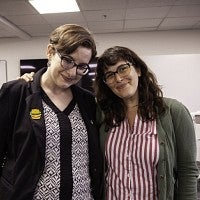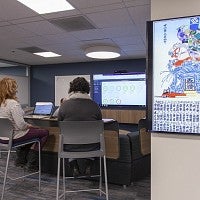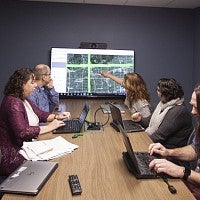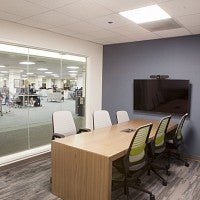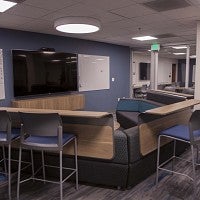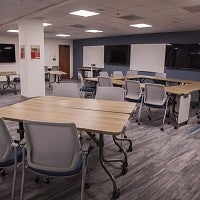Following an extensive remodeling on the first floor of Knight Library, a new resource space has recently opened its doors to the UO community.
“A donor-funded initiative, the Digital Research, Education and Media Lab will facilitate continued integration and expansion of digital scholarship and educational technology services for the university,” said Adriene Lim, dean of libraries and Philip H. Knight Chair. “It will serve as the Libraries’ new shared space for innovative teaching, course design consultation, research data management and use of primary source materials for digital scholarship.”
RELATED LINKS
Also known as the DREAM Lab, the space will be open 9 a.m. to 5 p.m. Monday through Friday during spring, fall and winter terms.
Resource areas in the lab include two private collaboration rooms that can accommodate groups of up to six. Another space combining sofas and bar-height seating has room for 12 collaborators. A workshop space with 32 seats can be left open or partitioned off with a sliding glass wall.
Large screens and videoconferencing technology are accessible in all spaces throughout the lab. With support for portable devices in mind, the space also was designed with an abundance of electrical outlets and hardwired data connections.
Faculty and staff members or graduate students can book DREAM Lab spaces through the library’s room reservation calendar. By special arrangement, the entire DREAM Lab may also be reserved for large workshops and events related to its core mission.
Franny Gaede, head of digital scholarship services with UO Libraries, said that the space was designed with flexibility, innovation and exploration in mind.
“I hesitate to name all the things that I hope will be accomplished in this space, as I don’t want to stifle creative and unexpected use," she said. "But, for a start, I’m excited to host hands-on workshops, edit-a-thons, mapathons, hackathons, write-ins, user testing, project meetings, brainstorming sessions, remote speakers, skill-building trainings, THATCamps and ever so much more. The DREAM Lab offers a dedicated and optimized space for the UO community to engage in digital scholarship and digital pedagogy, in whatever forms they may take.”
Regular programming for the DREAM Lab includes workshops on digital scholarship tools and techniques, data management and visualization, instructional design, accessibility, user experience, and assessment.
"The workshop space in the DREAM Lab is easy to find and it's a great learning space because it allows for flexible use," said Pat Fellows, an instructional technologist and designer with the library's Center for Media and Educational Technologies. "Regardless of the size of your group, we are able to engage our participants, make them feel comfortable and encourage them to actively participate."

Faculty members are saying . . .
-Heidi Kaufman, associate professor of English and director of digital humanities in the College of Arts and Sciences
"I use the collaboration room with a big screen to work on two projects with two other colleagues. In the first project, we’re transcribing an important interview that we will publish in a journal. In the second project, we are developing an ArcGIS map for an itinerant seminar that will take place this summer. The settings of the DREAM lab are perfect for collaborating with colleagues and brainstorming about bigger projects."
-Massimo Lollini, professor of Italian
"I scheduled our graduate seminar — ENG 607: Comics Theory — in the DREAM Lab twice during the quarter. The set-up is ideal for our purposes: We Skyped with comics writer Mat Johnson to discuss his work, and later we used the same screen to close-read digital comics as a group. The DREAM Lab has so many different spaces, and our seminar worked in an area that felt intimate and technologically advanced."
-Katherine Kelp-Stebbins, assistant professor of comics studies
Kate Thornhill, digital scholarship librarian, noted that the lab will be staffed by a team of student workers who will support users' technology needs and contribute to digital projects.
"I am very excited that we can offer employment opportunities for both GEs and undergraduates: everything from developing data visualizations to designing digital exhibits and learning about intellectual property rights," she said. "It is an opportunity for them to learn hard and soft skills in demand by today's employers."
While it is primarily intended for faculty members, graduate students and staff use, undergraduates will also have the opportunity to experience the lab during classes, workshop sessions and other scheduled events.
Scott Fisher, astronomy lecturer and outreach director with the Department of Physics, said he is looking forward to introducing his undergraduate research group to the DREAM Lab next fall. He and his students are collaborators in a large-scale astronomy program called the Gemini-Hubble Space Telescope Galaxy Cluster Project, or GCP.
"The leader of the project is Dr. Inger Jorgensen, who is based in Hilo, Hawaii; our main external collaborator is Dr. Ricardo Demarco from the University of Conception, in Chile," he said. "We will use the DREAM Lab to hold our weekly meetings with those collaborators and others from around the planet. It is especially useful to hold the meetings in the lab since we can use the advanced capabilities of the system — screen sharing, real-time collaboration — to give us at UO a chance to truly contribute to the GCP team. These meetings are a chance for UO undergraduates to directly collaborate with world-leading scientists that work at some of the largest telescopes in the world."
Lim noted, “In academia, we often talk about how research and scholarship should improve teaching and learning, and vice versa. This new space and the services and collaboration it enhances allow for us to explore this dynamic to a greater degree."
In summary, Gaede said, the lab is "a dream come true;" a state-of-the-art facility for today, it was also designed with an eye towards the university of the future.
“From partnering with colleagues across the globe or across campus to workshops on digital research methods to individual consultation on online course design, the DREAM Lab will help us meet the needs of an interdisciplinary, collaborative, innovative campus, as they exist now and whatever they may look like in the years to come,” she said.
—By Jason Stone, University Communications


